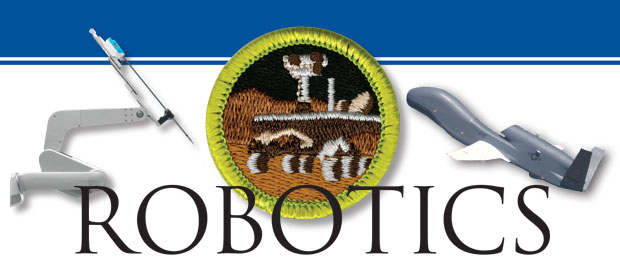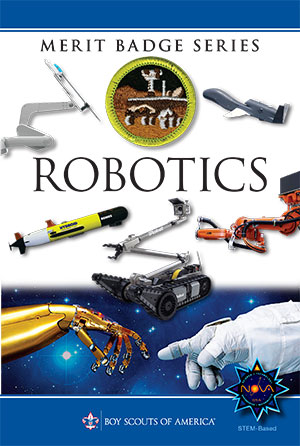Robotics merit badge

Earning the Robotics merit badge requires a Scout to understand how robots move, sense the environment, and understand what to do.
REQUIREMENTS
1. Safety. Do each of the following:
a. Explain to your counselor the most likely hazards you may encounter while working with robots and what you should do to anticipate, mitigate and prevent, and respond to these hazards. Describe the appropriate safety gear and clothing that should be used when working with robotics.
b. Discuss first aid and prevention for the types of injuries that could occur while participating in robotics activities and competitions, including cuts, eye injuries, and burns (chemical or heat).
2. Robotics industry. Discuss the following with your counselor:
a. The kinds of things robots can do and how robots are best used today.
b. The similarities and differences between remote control vehicles, telerobots, and autonomous robots.
c. Three different methods robots can use to move themselves other than wheels or tracks. Describe when it would be appropriate to use each method.
3. General knowledge. Discuss with your counselor three of the five major fields of robotics (human-robot interface, mobility, manipulation, programming, sensors) and their importance to robotics development. Discuss either the three fields as they relate to a single robot system OR talk about each field in general. Find pictures or at least one video to aid your discussion.
4. Design, build, program, test. Do each of the following:
a. With your counselor’s approval, choose a task for the robot or robotic subsystem that you plan to build. Include sensor feedback and programming in the task. Document this information in your robot engineering notebook.
b. Design your robot. The robot design should use sensors and programming and have at least 2 degrees of freedom. Document the design in your robot engineering notebook using drawings and a written description.
c. Build a robot or robotic subsystem of your original design to accomplish the task you chose for requirement 4a.
d. Discuss with your counselor the programming options available for your robot. Then do either option 1 OR option 2.
(1) Option 1. Program a robot to perform the task you chose for your robot in 4a. Include a sample of your program’s source code in your robot engineering notebook.
(2) Option 2. Prepare a flow chart of the desired steps to program your robot for accomplishing the task in 4a. Include procedures that show activities based on sensor inputs. Place this in your robot engineering notebook.
e. Test your robot and record the results in your robot engineering notebook. Include suggestions on how you could improve your robot, as well as pictures or sketches of your finished robot.
5. Demonstrate. Do the following:
a. Demonstrate for your counselor the robot you built in requirement 4.
b. Share your robot engineering notebook with your counselor. Talk about how well your robot accomplished the task, the improvements you would make in your next design, and what you learned about the design process.
6. Competitions. Do ONE of the following:
a. Attend a robotics competition and report to your counselor what you saw and learned about the competition and how teams are organized and managed.
b. Learn about three youth robotics competitions. Tell your counselor about these, including the type of competition, time commitment, age of the participants, and how many teams are involved.
7. Careers. Name three career opportunities in robotics. Pick one and find out the education, training, and experience required for this profession. Discuss this with your counselor, and explain why this profession might interest you.
RESOURCES
The Robotics merit badge pamphlet and the new interactive digital merit badge pamphlet are filled with resources to help you learn about robots. Here is a sample of what you can find in those pamphlets:
What Qualifies as a Robot for the Robotics Merit Badge?
What are “Degrees of Freedom?”
Robotics Safety and First Aid
This video can help you get started with requirement 1.
Methods Robots Use to Move
This video can help you get started with requirement 2c.
Careers in Robotics
This video can help you get started with requirement 7.
ASK AN EXPERT
Have a question about robotics? Stuck on a technical issue that you can’t figure out? Experts Tarek Shraibati, Rick Tyler, and Kenneth Berry are here.
- Should my son join a FTC or VRC after Lego?
- What does ‘2 degrees of freedom’ mean in requirement 4b?
- Is Electronics merit badge a prerequisite for Robotics?
- Do you all think that the Arduino kits would make a good match for this badge?
- Is the Lego Mindstorms NXT kit compatible with the requirements?
ROBOTICS RESOURCES
- Download a Robotics merit badge workbook
- Robotics competitions
- Robotics 101 (courtesy of National Robotics Week)
- Overview of the engineering design process (courtesy of VEX)
- Articles, books and links

Requirement #4 is very clear when it says “Design.” Building a kit that someone else designed does NOT meet this requirement. Either change the requirement or throw out references to a kit.
This was very helpful to me in getting the Robotics Merit Badge
You offer kits but require original design..can you use a kit or not..i am confuse..mother of Autistic Boy Scout.
This stuff wasn’t useful at all! It was really annoying. Why don’t you do a burn first aid and prevention robotics guide. I really need this merit badge and this so called “guide” didn’t help at all!
-From a VERY annoyed Boy Scout